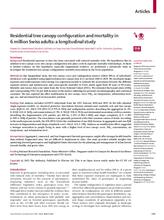Background
Residential exposure to trees has been associated with reduced mortality risks. We hypothesise that in addition to tree canopy cover, tree canopy configuration also plays a role in exposure–mortality relationships. As there is limited evidence on this hypothesis, especially longitudinal evidence, we performed a nationwide study to investigate the residential tree canopy configuration–mortality associations in the Swiss population.
Methods
In this longitudinal study, the tree canopy cover and configuration metrics within 500 m of individuals’ residences were quantified using high-resolution tree canopy data (1 × 1 m) from 2010 to 2019. We developed single-exposure and multi-exposure time-varying Cox regression models to estimate the associations between the different exposure metrics and natural-cause and cause-specific mortality in Swiss adults (aged from 20 years to 90 years). Mortality and census data were taken from the Swiss National Cohort (SNC). We estimated the hazard ratios (HRs) and corresponding 95% CIs per IQR increase in the metrics adjusting for personal sociodemographic and contextual covariates. We also explored the effect modification by tree canopy cover, PM10, air temperature, urbanisation level, age, sex, and area-based local socioeconomic position.
Findings
Our analyses included 6 215 073 individuals from the SNC between 2010 and 2019. In the fully adjusted single-exposure models, we observed protective associations between natural-cause mortality risk and tree canopy cover (IQR 12·4%, HR 0·979 [95% CI 0·975–0·983]) and configuration metrics describing the aggregation (6·3%, 0·831 [0·823–0·840]), and connectedness (2·9%, 0·946 [0·938–0·953]); and detrimental associations with two metrics describing the fragmentation (211 patches per 100 ha, 1·073 [1·066–1·080]) and shape complexity (1·9, 1·094 [1·089–1·100]) of patches. The associations were generally preserved with other common causes of death. According to the multi-exposure models, the HR (95% CI) for the combination of one IQR decrease in aggregation and one IQR increase in fragmentation and shape complexity was 1·366 (1·343–1·390). Analyses on modification effects suggested a stronger association in people living in areas with a higher level of tree canopy cover, PM10 concentration, air temperature, and urbanisation level.
Interpretation
Aggregated, connected, and less fragmented forested greenspaces might offer stronger health benefits than isolated, fragmented ones, but are difficult to implement in cities. Our study provided valuable insights into optimising forested greenspaces and highlighted future directions for the planning and management of urban forests towards healthy and green cities.



